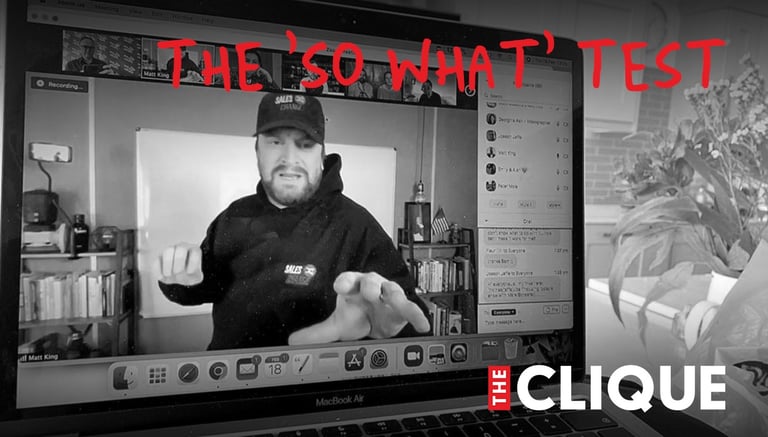The 'So What' Test


👨🏼💼 What?
‘What’ is a powerful word and it allows you to question something with clarity.
My kids use ‘What?’ all the time - it means you get to second guess your attempt to stop them watching Youtube at 7:45am as you’re trying to leave the house for school.
‘What?’ buys time for them but it also means they get to question your authority and every time you post a piece of content or you open your mouth in a sales call - inside the prospect/reader’s head is a silent alarm bell which rings with a loud ‘So What?’ every time you make a statement.
It’s their way of ascertaining value from you and if you make sweeping statements or you’re continually promoting a product which no-one sees the value in then the chances of you resonating with them are minimal.
🧐 What do I mean?
I’m going to take two examples in this article and break them down - one from a sales perspective and one from a content production perspective.
From a sales perspective - the first time I heard about the ‘So What?’ test was in Mike Weinberg’s book - ‘New Sales : Simplified’ in which he emphasizes the importance of the "So What" test in sales to ensure that your sales messaging and value proposition resonate with your customers and prospects.
The "So What" test is a method to evaluate the relevance and impact of what you're presenting or communicating to your audience. It helps you determine if your message effectively addresses the needs, concerns, and interests of your potential customers.
This stuck with me as it was a way to check everything that you chat about with your prospects and it gave me a gauge by which to check on the effectiveness of what I was saying.
Mike uses an example of the classic ‘We’ve been in business for 60 years’ or another similar timeframe as if the longevity in the marketplace equals instant value in the eyes of the client.
The grand old phrase of’ The client doesn’t care what you do, they only care what you can do for them’ instantly springs to mind and you start to clear the fog around your well trodden phrases so that you become effective in what you say.
I’ve lost count of the number of times I’ve been in a sales call and I’ve heard someone open their ‘pitch’ with a line about when the company was formed or how many staff they have across the world - another favourite is to beat your chest in a sales call and tell everyone how much money the company turns over in a year.
All these things are relative. Nothing you say actually matters to a prospect, they just want to hear or talk about the bit they are actually interested in and that’s the bottom line.
You could skip right over the fluffy nice bits about your company and go straight to the question of ‘What do you need?’ and I think most clients would be relieved they don’t have to sit through the puffy chest bravado.
😟 What are you posting?
This is my current pet-hate.
I’ve warned you right?
Ok - let’s go.
What the f*ck are you posting about?
I’m as guilty as the rest when it comes to posting on LinkedIn about something that no-one is going to care about and it's such an easy trap to fall into and I think you need to understand what you’re posting and what the context is.
I see so many people just promoting - posting pictures of their products or a screenshot of their positive feedback and that’s it.
I see a ton of people who only post about their podcast or their video series as if someone is suddenly going to understand what they are likely to get from it.
In both these incidences (and I’m sure you’ve seen both in your feed) - the ‘creator’ only cares about themselves. They have created that content so why shouldn’t you see it.
W'e’re back to the ‘So What'‘ test again.
Why should they care about your podcast - sure, you’ve got a great tagline and it’s on a mission to blah, blah, blah but the podcasts that deliver and do it really well highlight what the listener is going to get out of each episode.
The guy that posts a 17 page carousel with a clearly worded title, a clear and concise caption and a catchy hook will probably get more views and more comments (not metrics we’re looking for here) than downloads of your podcast.
What am I trying to say here?
I went off on a little rant I think but I’m trying to get across that the content you create should focus on your audience and not you.
Read that again.
Your content should focus on your audience and not you.
🫴🏻 What do we do instead?
I thought you'd want to know what I would do (and what I try to do) when I create content or stand up in front of people to deliver a pitch because the premise is the same in both instances.
Whenever you begin to craft that statement or piece of content - start by thinking immediately ‘What will my audience gain from this?’ - now, this can be extremely debilitating as it will often lead to the realisation that your audience won’t actually gain anything from that picture of a valve you’ve posted but then you need to think about the ‘whole’ picture - what about the caption you’re going to add or in a sales instance - what are the supporting statements you’re going to make about your point.
👍🏻 Ask ‘So What!’
The whole point of this blog article - Ask "So What?": After creating the content, ask yourself, "So What?" in the context of your target audience. Consider why your audience should care about this content. What value does it provide to them? What problem does it solve or what benefit does it offer?
Literally put yourself in your audience shoes and listen to what you’re saying back.
Remember, if you’ve planned your sales call (more on that to come in the next few weeks) then you should be focusing on questioning the prospect, not presenting to them.
🤡 How do we ask ‘So What?’
To ask ‘So What?’ of your content or sales statement means that you need to evaluate the value and the relevance.
You need to be critical and analyze the content from the perspective of your intended audience.
Does the content address their needs, interests, or pain points?
Does it offer valuable insights, knowledge, entertainment, or solutions? Ensure that the content is meaningful and relevant to your audience.
Only by looking at yourself through your clients eyes will you be able to understand whether what you’re doing or saying is hitting the mark.
This is where a lot of people fall down I think - they see their content or their sales statement through ego. They see their content as a vehicle to spread their value but the vehicle being presented to the audience is a bag of shit.
Who want’s value delivered to them in a Ford Fiesta?
💩 What if it doesn’t pass the test?
Every single time, you need to get batter at enhancing the value and the relevance of your content.
If the content doesn't pass the "So What" test initially, revise and refine it to enhance its value and relevance. As I said - the picture of your product may mean something to you and it may be presented in one of the most beautiful ways possible but if it becomes ‘just another picture’ or your podcast becomes ‘just another podcast’ then what’s the point?
Why don’t you instead think about what you’re doing in some deeper way and consider adding more context, addressing specific concerns, providing additional information, or refining the messaging to make it more relevant - make people want to care.
Posting relentlessly doesn’t work either.
Volume doesn’t equal value.
You need to remember to matter more to people instead of marketing more.
🪃 Lets wrap up.
1. Significance of 'What' and the 'So What' Test:
"What" is a powerful word that prompts questioning with clarity, helping evaluate statements or messages (or in my kid’s case - buys you more time to evaluate what’s next)
The "So What" test is crucial, especially in sales and content creation, to ensure that messages convey value and relevance to the audience.
2. The Application of ‘So What?’ in Sales and Content Production:
The "So What" test, which I was first introduced to by Mike Weinberg, emphasizes evaluating the relevance and impact of sales messaging and value proposition to resonate with customers and prospects. Stop telling everyone how old your company is.
In content production, you have to focus on audience benefits, needs, and interests rather than self-promotion or irrelevant details about the yourself or your offerings. Nobody will care about your podcast until they get something from it.
3. How to Implement the 'So What' Test:
Before creating content or delivering a sales pitch, consider what the audience will gain from it and how it addresses their needs or concerns.
Put yourself in your audience's shoes, questioning the content's value and relevance, ensuring it offers insights, solutions, or entertainment meaningful to them.
If the content doesn't pass the "So What" test, revise and enhance its value and relevance by adding context, refining the messaging to resonate with the audience better.
My final point - Quality matters more than volume when it comes to content.


